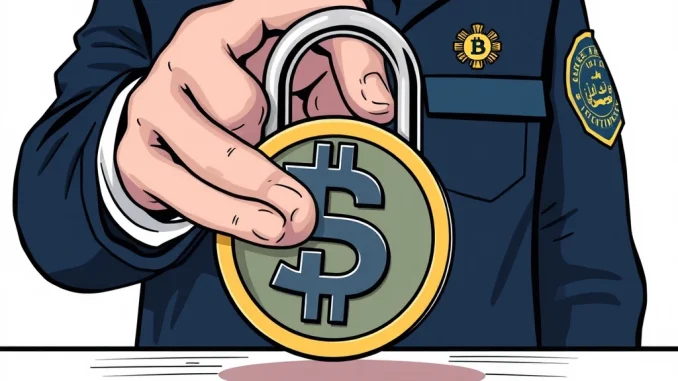
Recent reports highlight ongoing government activity in the cryptocurrency space. According to data shared by Arkham Intelligence on X (formerly Twitter), the US government has executed a USDT seizure totaling $40,000. While the amount might seem small compared to larger confiscations, it signals continued vigilance by authorities regarding digital assets.
What the $40K USDT Seizure Means
This specific USDT seizure involves Tether’s stablecoin, pegged to the US dollar. The amount, $40,000, is relatively modest in the context of government asset forfeitures, especially those involving cryptocurrencies which have sometimes reached millions or billions of dollars. However, the act itself is noteworthy. It demonstrates that government agencies are actively monitoring transactions and have the capability to identify and seize even smaller amounts of digital assets like USDT when linked to investigations or illicit activities.
Key points about this event:
- Asset: $40,000 in USDT (Tether stablecoin).
- Entity: The U.S. government.
- Source of Information: Reported by Arkham Intelligence.
- Significance: Indicates active government monitoring and seizure capabilities for digital assets, regardless of amount.
Arkham Intelligence: Shedding Light on On-Chain Activity
The information about this seizure comes from Arkham Intelligence, a platform specializing in on-chain data analysis. Arkham tracks and labels blockchain addresses, providing insights into the flow of funds and identifying entities involved in transactions. Their ability to link specific addresses to known entities, such as government agencies or individuals, makes them a valuable resource for tracking seized assets or investigating suspicious activity. Their report confirms the transaction details on the blockchain, validating the government’s action.
The Broader Trend: Government Crypto Seizure
This $40,000 USDT seizure fits into a larger pattern of government crypto seizure actions globally, particularly in the United States. Law enforcement agencies like the FBI, IRS, and Department of Justice have increasingly targeted cryptocurrencies used in illicit activities, including scams, ransomware attacks, and money laundering. Seizing crypto assets is a critical tool for disrupting criminal operations and recovering funds. While Bitcoin and Ethereum have historically been the most commonly seized assets, this event shows that stablecoins like USDT are also on the radar.
Examples of government crypto seizures:
- Seizures related to the Silk Road dark web marketplace.
- Confiscations from individuals involved in hacking or fraud schemes.
- Assets taken from ransomware attackers.
These actions highlight the traceability of blockchain transactions, countering the misconception that crypto is entirely anonymous and beyond the reach of authorities.
Navigating Crypto Regulation in the US
The continuous activity around seizures underscores the evolving landscape of crypto regulation in the US. Regulatory bodies and law enforcement are developing sophisticated methods to track, identify, and seize digital assets involved in illegal activities. This proactive approach aims to protect consumers and maintain financial integrity, but it also raises questions about privacy and the extent of government surveillance in the digital asset space. As regulations mature, we can expect more clarity on how digital assets are treated under the law, including procedures for seizure and forfeiture.
Actions by the US Government in the Crypto Space
Beyond seizures, the US government is engaged in multiple facets of the crypto ecosystem. This includes:
- Developing regulatory frameworks (e.g., discussions around stablecoin legislation, exchange oversight).
- Investigating illicit use of crypto.
- Exploring potential uses of blockchain technology (e.g., central bank digital currencies – CBDCs, though this is a separate topic).
- Educating the public and industry about compliance requirements.
Each action, including a small USDT seizure, contributes to the broader narrative of how traditional financial systems and government oversight are adapting to decentralized technologies.
What Does This Mean for Crypto Users?
For legitimate users of cryptocurrencies, this seizure serves as a reminder of the importance of compliance and understanding the regulatory environment. While crypto offers many benefits, it is not immune to law enforcement action when associated with crime. Using reputable exchanges and wallets, understanding KYC/AML procedures, and being aware of the source of your funds are prudent steps in navigating the digital asset space responsibly.
Conclusion
The recent $40,000 USDT seizure by the US government, as reported by Arkham Intelligence, is a small but significant data point. It confirms the ongoing capability and willingness of authorities to act against the illicit use of digital assets. This event contributes to the broader picture of increasing government crypto seizure activities and the evolving landscape of crypto regulation. As the crypto market matures, interactions between government bodies and digital assets will likely become more frequent, shaping the future of the industry.



